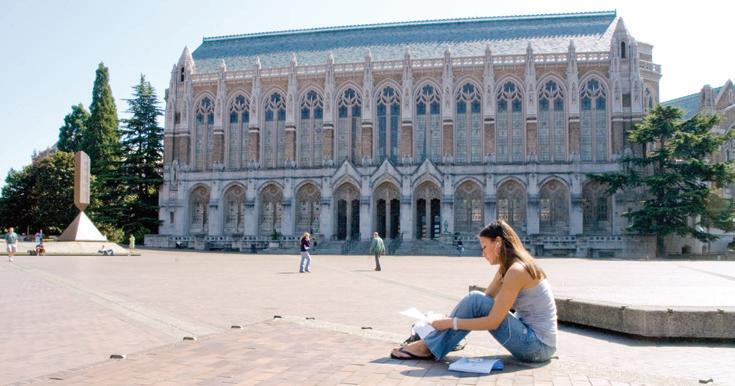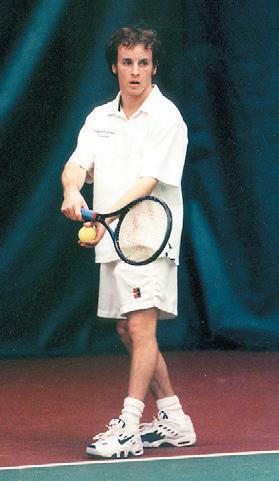
14 minute read
From the Athletic Director’s Desk
GOHUSKIES
VOLUME 13 / ISSUE 7 / JUNE 2020
For Information on Advertising, Please Call Brandon Forbis at (206) 695-2562. GoHuskies Magazine is published seven times a year by Huskies Sports Properties, in conjunction with the University of Washington Athletic Department.
GOHUSKIES MAGAZINE
Huskies Sports Properties 3910 Montlake Boulevard – Box 354070 Seattle, WA 98195
All material produced in this publication is the property of Huskies Sports Properties and shall not be reproduced in whole or in part without permission from Huskies Sports Properties and the University of Washington Athletic Department. Please send all address changes to the attention of Tyee Club at University of Washington; Box 354070; 202 Graves Building; Seattle, WA 98195-4070 or by email at huskies@uw.edu.
EDITOR Brian Beaky
WRITERS Jack Larkin, Brian Tom
PHOTOGRAPHERS Matthew Lipsen, Don Jedlovec, Jonathan Moore, Red Box Photography, UW Athletics
ADVERTISING
Brandon Forbis, Kate Hughes (206) 695-2562 brandon.forbis@ HuskiesSportsProperties.com
DESIGN Robert Becker
FROM THE ATHLETIC DIRECTOR’S DESK
miss you, Husky Nation. It’s been several weeks now since we’ve been together cheering on our I beloved Huskies and we are all anxiously awaiting the return of our amazing students to Montlake. These have been some of the most challenging times for each of us, as we deal with these unimaginable circumstances. As tough as this has been, I’m optimistic about what is to come and the progress we are making as we prepare to move forward.
It has been an honor to watch the heroes at our university — the health care providers and researchers on the front lines of this pandemic — make national headlines as the leaders and difference-makers who are searching for and finding the answers that this country needs. We are so fortunate to work at this world-class institution and live in a world-class city.
More specifically to our department, we have a committee that has been diligently working to build a robust plan for us to resume operations again in our athletics footprint and bring students back to Montlake when it is safe to do so. We will continue to follow University, local and state guidance on appropriate measures needed to maintain the safest environment for all. But, I’m encouraged by the work of our great team as we continue to take steps in a positive direction.
We are focusing a lot of our efforts on options for safely hosting spectators inside our venues. We are currently working through several different scenarios, and are exploring everything from the way fans enter and exit the stadium, to concessions, seating arrangements and sanitation stations, with the safety and well-being of each of you as our top priority. As it is still too early to know what state guidelines will allow, we are hopeful we will be able to have you join us inside venues this fall, as we know you create an unmatched home-field and home-court advantage
Jennifer Cohen
for our student-athletes.
We are all in this together and we can draw on the knowledge that with great challenges come incredible growth opportunities. I am confident that together as Huskies – student-athletes, coaches, staff and fans – we will emerge stronger than ever.
I want to express my compassion, sympathy, and well wishes for all in our community who have been directly affected by this pandemic. In these difficult times, we are thinking of nothing more than your health, safety and well-being.
I want to also thank our amazing fans, season ticket holders and Tyee Club members. Your unwavering support gives us the ability to continue to provide our 650 student-athletes and 22 teams with the critical resources they need to succeed. There are many unknowns ahead, but one thing that I know is that our supporters have always been there for us, right alongside us, as we together work to achieve our dreams. This will be no different.
We will all get through this and I can’t wait to join you again as we cheer on our beloved Huskies! Go Dawgs!
Football & Men’s Basketball Flagship Radio Station: KOMO Newsradio AM 1000 & FM 97.7



Back

In

The Trenches
Their playing careers long behind them, Husky athletic alumni find themselves battling one of the toughest foes of their lives
BY BRIAN BEAKY T here are days that Scott Stuart never wants to forget. Like Jan. 1, 1992, the day he and his Husky football teammates crushed the fourth-ranked Michigan Wolverines in the Rose Bowl to finish off a perfect, 12-0 season, and clinch a share of the National Championship.
Then, there are others that he'll never be able to forget, no matter how much he might want to.
February 29, 2020, was one of those days.
Now an internal medicine hospitalist practicing general medicine at Evergreen Health in Kirkland — as Stuart describes it, "If grandma has to be admitted to the hospital, I'm her doctor" — Stuart had participated in a meeting the day before where the hospital's infectious disease specialist had suggested that two patients in the ICU be tested for COVID-19, despite having no obvious connections to prior COVID-19 patients diagnosed around the Seattle area, and no recent travel to hotspots like China or Italy. "At the time, it felt so distant," recalls Stuart, who spent the better part of a decade after walking off the field at the Rose Bowl pursuing a medical degree at UW and working in residencies throughout the area. "We had a sense that it might be in circulation, but we had no evidence. There had been a patient admitted to Providence in Everett the month before who we knew had spread virus for a while, but we thought the contact tracing had been sufficient and that we had a good sense of who might have been exposed. In short, we just didn't think there was community spread at that point. "I remember thinking that there was no more than a fifty-fifty chance that either of our two patients had the virus," he continues.
The next day — Feb. 29 — the results of both tests came back positive for COVID-19. "I couldn't believe it. I thought, 'Wow, it's here. There's community spread,'" he recalls. "It was a real tip-of-the-iceberg feeling, because I knew from following events in China and Italy what we were in for."




“It’s my job to make sure that everybody is prepared to see COVID patients,” says Berman, who played tennis at UW from 1996-2001.

Stuart, like many of his fellow UW athletic alumni, has spent the past few months locked in battle with one of the toughest foes they've ever faced — COVID-19, the disease caused by the SARS-CoV-2 virus that first emerged in China late last year. Once stars on the track, football and soccer field, basketball, volleyball and tennis courts, they are now doctors, nurses, firefighters, paramedics and hospital administrators, all working together to treat patients in need. Their training — both academically and athletically — has given them many skills that have helped them be successful in life. But, nothing could have adequately prepared them for this.
Stuart recalls the first few weeks after that initial moment of shock as a whirlwind. "My group took care of the first big flood of patients that came in from LifeCare and some of the other nursing homes at the beginning of March," he recalls. "It was overwhelming. I was admitting 2-3 severely ill patients per shift. Half of our emergency room was allocated just for coronavirus. We had it all blocked off, with temporary plastic walls, negative air pressure, everything. I'd go down there, in full protective gear, and just see people back to back to back, all sick and scared. I was scared, too. But, you have to keep your composure, because they are even more scared than you are. "A friend of mine who was an ER doc got really sick, and then I admitted the mom of one of my colleagues, and she was really sick," he adds. "That was the low point for me, the point where I felt like maybe this was getting beyond our control. We didn't have an antiviral, a vaccine was a long ways away — as a doctor, when you have a global feeling of helplessness, that you don't have many weapons to use, that's a really scary feeling."
It's a feeling that Jeremy Berman knows well. A four-year letterwinner in tennis for Washington from 1996-2001 (including a redshirt season) who still ranks sixth in program history in career singles wins (91), Berman now works as the medical director for Landmark Health, a provider group that offers primary care, nursing, behavioral health, urgent care and other services to chronically ill patients in their homes. Landmark's patients are often the oldest, and/or sickest in the area — in other words, the exact population that has proven to be most at-risk to serious complications from COVID-19. "It's my job to make sure that everybody is prepared to see COVID patients," explains Berman, who spent 18 months playing professional tennis after college before embarking on his medical career. "Originally, we shifted a lot of visits to telemedicine, but that's not an optimal situation for our patients, who are older and hard of hearing, or limited in their understanding and use of technology. Now that we have adequate supplies of PPE (personal protective equipment), we have transitioned back into the home and are getting out to see our patients more and more."
Berman says that, ironically, the seriousness of his patients' conditions has, in some ways, actually protected them from coronavirus exposure. "Because our patients are already largely socially isolated, they are in some ways actually at a lower risk of getting it," he says. "Of course, if and when they do get it, the complications are usually more serious. A number of patients have gotten sick, and some of them have done O.K. But, some of them haven't."



In addition to the physical treatment that Landmark's patients have required during this time, Berman says that the mental and psychological challenges have required deft management as well. "Our patients are experiencing even more social isolation than they were before," he says. "They are no longer able to see their loved ones. Some are afraid to have health professionals come into their homes. There's a higher amount of anxiety, a higher amount of loneliness. But, we still have to find a way to get them their medications, do needs assessments, et cetera. There are some real challenges our population is facing that are unique to them, as opposed to the healthier population." hen Stuart leaves Evergreen each day, he has to undergo a complicated ritual before seeing W his family. First, before leaving the hospital, he changes out of the scrubs that he worked in that day and places them in a hamper, before donning clean scrubs for the drive home. Before entering the house, he changes out of the "hospital shoes"

that he keeps in his truck and into a pair of Vans waiting outside the door of his home, and puts the scrubs that he is currently wearing into a sealed bag. Stuart then proceeds directly to the laundry room to put all of his clothes, including the scrubs worn on the drive home, into the wash, and takes a long shower, vigorously cleaning off any aerosolized virus that may have come in contact with his skin or hair throughout the day. Only then does Stuart finally greet his family, including his college-sweetheart wife and young daughter.
He's one of the lucky ones, he says. Some doctors and nurses with younger children, elderly family living at home, or immunosuppressed partners have had to quarantine themselves from their families entirely, either in separate rooms of the house, or even in hotel rooms. But, Stuart says, despite the many challenges they've had to face, he continues to be amazed by the professionalism, dedication and collegiality of the medical professionals he interacts with on a daily basis. "It's actually a lot like playing football, when you're all moving in the same direction, and everyone is working together for a common cause," he says. "The camaraderie has been remarkable. I'll go into the ICU, and there will be a group of therapists and nurses all in the gear, working together to turn a patient over on to their stomach, and they'll be working so gently and fluidly. There's a real art to it, and it's beautiful to see them all working together so seamlessly."
Stuart extended the football analogy to say that if the fight against the coronavirus were a football game, we're currently somewhere near the end of the first quarter, with a significant amount of work still ahead of us. "It's been an action-packed first quarter, too," he says. "I have a feeling that the second quarter is going to come this fall and winter, when we see if we have another surge. Assuming that we are able to relax social distancing over the summer, will people be willing to social distance again if indeed we need them to? That's going to be incredibly hard."




Berman agrees that the need for social distancing remains high — and, like Stuart — worries that the average person, cooped up inside for the last two months, potentially out of work and eager to return to normal life, may underestimate the virus' potential to return later this year. "There continues to be a misperception that we can lift these physical restrictions before we have the testing and contact tracing set up in a big way without risking harm," he says. "There's a real need to get back to normal life, especially for people who are suffering economically, and it's obviously difficult to weigh that against the need to remain physically distanced until we have public health measures set up to really contain the virus."
Both medical professionals see hope in the ongoing efforts of scientists, doctors and researchers around the world — and, particularly, here at home. Berman points to the Washington Department of Health website as an excellent resource for accurate and up-to-date information, while Stuart cites UW's Institute for Health Metrics and Evaluation, which has emerged as one of the world's foremost modelers of the epidemic and its spread. In addition, many UW researchers are on the front lines of vaccine and anti-viral development, while UW-trained doctors, nurses and other medical professionals are staffing many of the area's major hospitals, developing new treatments and becoming leading experts on managing and assisting patients who have contracted the virus.
Stuart says that it's the incredible commitment he has seen from those professionals in the field, and the willingness of the local community to accept major lifestyle changes, that has him optimistic that we as a community will be able to work together to overcome this crisis. "When we first started seeing a lot of cases, it was almost immediate; the tech community announced they were going to start working from home, then schools closed, and stuff was shut down voluntarily pretty well," he says. "I was proud of us as a community. If it weren't for people being willing to take on those burdens, my hospital would still be inundated, and we'd still be having to make decisions about who to treat and who to send somewhere else. We've all really pulled together, and we're finally starting to get our bearings. "So, that's what gives me a lot of hope," Stuart adds, "That's what keeps me going. We did it once, and we'll do it again if we have to."











